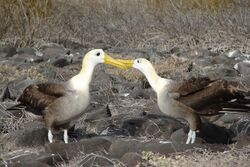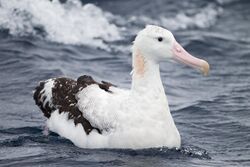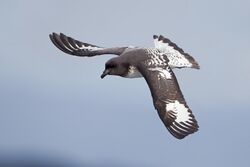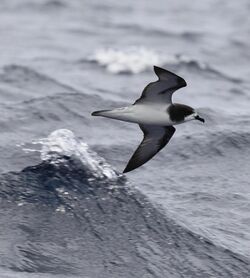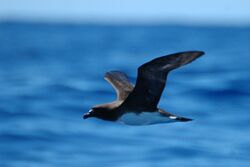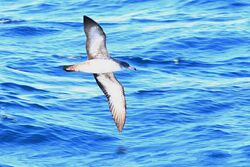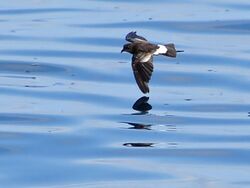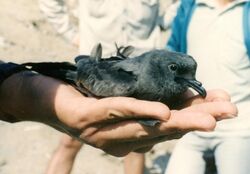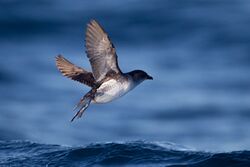Biology:List of procellariiformes
This is a list of the families, species and subspecies of the order Procellariiformes.

Conservation status - IUCN Red List of Threatened Species:
- EX - Extinct, EW - Extinct in the wild
- CR - Critically endangered, EN - Endangered, VU - Vulnerable
- NT - Near threatened, LC - Least concern
- DD - Data deficient, NE - Not evaluated
- (v. 2021-3, the data is current as of February 25, 2022[1])
Albatrosses
Order: Procellariiformes Family: Diomedeidae
The albatrosses are a family of 21 species of large seabird found across the Southern and North Pacific Oceans. The largest are among the largest flying birds in the world.
- Laysan albatross, Phoebastria immutabilis NT
- Black-footed albatross, Phoebastria nigripes NT
- Waved albatross, Phoebastria irrorata CR
- Short-tailed albatross, Phoebastria albatrus VU
- Wandering albatross, Diomedea exulans VU
- Antipodean albatross, Diomedea antipodensis EN
- Amsterdam albatross, Diomedea amsterdamensis EN
- Southern royal albatross, Diomedea epomophora VU
- Northern royal albatross, Diomedea sanfordi EN
- Tristan albatross, Diomedea dabbenena CR
- Sooty albatross, Phoebetria fusca EN
- Light-mantled albatross, Phoebetria palpebrata NT
- Black-browed albatross, Thalassarche melanophris LC
- Campbell albatross, Thalassarche impavida VU
- Shy albatross, Thalassarche cauta NT
- Chatham albatross, Thalassarche eremita VU
- Salvin's albatross, Thalassarche salvini VU
- Grey-headed albatross, Thalassarche chrysostoma EN
- Atlantic yellow-nosed albatross, Thalassarche chlororhynchos EN
- Indian yellow-nosed albatross, Thalassarche carteri EN
- Buller's albatross, Thalassarche bulleri NT
Fulmars, petrels, prions and shearwaters
Order: Procellariiformes Family: Procellariidae
The procellariids are the main group of medium-sized "true petrels", characterized by united nostrils with medium nasal septum, and a long outer functional primary flight feather.
- Southern giant petrel, Macronectes giganteus LC
- Northern giant petrel, Macronectes halli LC
- Northern fulmar, Fulmarus glacialis LC
- Southern fulmar, Fulmarus glacialoides LC
- Antarctic petrel, Thalassoica antarctica LC
- Cape petrel, Daption capense LC
- Snow petrel, Pagodroma nivea LC
- Blue petrel, Halobaena caerulea LC
- Broad-billed prion, Pachyptila vittata LC
- Salvin's prion, Pachyptila salvini LC
- Antarctic prion, Pachyptila desolata LC
- Slender-billed prion, Pachyptila belcheri LC
- Fairy prion, Pachyptila turtur LC
- Fulmar prion, Pachyptila crassirostris LC
- Kerguelen petrel, Lugensa brevirostris LC
- Great-winged petrel, Pterodroma macroptera LC
- White-headed petrel, Pterodroma lessonii LC
- Atlantic petrel, Pterodroma incerta EN
- Providence petrel, Pterodroma solandri VU
- Magenta petrel, Pterodroma magentae CR
- Murphy's petrel, Pterodroma ultima LC
- Soft-plumaged petrel, Pterodroma mollis LC
- Zino's petrel, Pterodroma madeira EN
- Fea's petrel, Pterodroma feae NT
- Desertas petrel, Pterodroma deserta VU
- Bermuda petrel, Pterodroma cahow EN
- Black-capped petrel, Pterodroma hasitata EN
- Jamaican petrel, Pterodroma caribbaea CR
- Juan Fernandez petrel, Pterodroma externa VU
- Vanuatu petrel, Pterodroma occulta (P. cervicalis: VU)
- Kermadec petrel, Pterodroma neglecta LC
- Herald petrel, Pterodroma heraldica LC
- Trindade petrel, Pterodroma arminjoniana VU
- Henderson petrel, Pterodroma atrata EN
- Phoenix petrel, Pterodroma alba EN
- Barau's petrel, Pterodroma baraui EN
- Hawaiian petrel, Pterodroma sandwichensis EN
- Galapagos petrel, Pterodroma phaeopygia CR
- Mottled petrel, Pterodroma inexpectata NT
- White-necked petrel, Pterodroma cervicalis VU
- Black-winged petrel, Pterodroma nigripennis LC
- Chatham petrel, Pterodroma axillaris VU
- Bonin petrel, Pterodroma hypoleuca LC
- Gould's petrel, Pterodroma leucoptera VU
- Collared petrel, Pterodroma brevipes VU
- Cook's petrel, Pterodroma cookii VU
- Masatierra petrel, Pterodroma defilippiana VU
- Stejneger's petrel, Pterodroma longirostris VU
- Pycroft's petrel, Pterodroma pycrofti VU
- Mascarene petrel, Pseudobulweria aterrima CR
- Saint Helena petrel, Pseudobulweria rupinarum EX
- Tahiti petrel, Pseudobulweria rostrata NT
- Beck's petrel, Pseudobulweria becki CR
- Fiji petrel, Pseudobulweria macgillivrayi CR
- Grey petrel, Procellaria cinerea NT
- White-chinned petrel, Procellaria aequinoctialis VU
- Spectacled petrel, Procellaria conspicillata VU
- Black petrel, Procellaria parkinsoni VU
- Westland petrel, Procellaria westlandica EN
- Streaked shearwater, Calonectris leucomelas NT
- Scopoli's shearwater, Calonectris (diomedea) diomedea (C. diomedea including C. (d.) borealis and C. (d.) diomedea: LC)
- Cory's shearwater, Calonectris (diomedea) borealis (C. diomedea including C. (d.) borealis and C. (d.) diomedea: LC)
- Cape Verde shearwater, Calonectris edwardsii NT
- Wedge-tailed shearwater, Puffinus pacificus LC
- Buller's shearwater, Puffinus bulleri VU
- Sooty shearwater, Puffinus griseus NT
- Short-tailed shearwater, Puffinus tenuirostris LC
- Pink-footed shearwater, Puffinus creatopus VU
- Flesh-footed shearwater, Puffinus carneipes NT
- Great shearwater, Puffinus gravis LC
- Christmas shearwater, Puffinus nativitatis LC
- Manx shearwater, Puffinus puffinus LC
- Yelkouan shearwater, Puffinus yelkouan VU
- Balearic shearwater, Puffinus mauretanicus CR
- Bryan's shearwater, Puffinus bryani CR
- Black-vented shearwater, Puffinus opisthomelas NT
- Townsend's shearwater, Puffinus auricularis CR
- Newell's shearwater, Puffinus newelli CR
- Rapa shearwater, Puffinus myrtae CR
- Fluttering shearwater, Puffinus gavia LC
- Hutton's shearwater, Puffinus huttoni EN
- Audubon's shearwater, Puffinus lherminieri LC
- Persian shearwater, Puffinus persicus LC
- Tropical shearwater, Puffinus bailloni LC
- Galapagos shearwater, Puffinus subalaris LC
- Heinroth's shearwater, Puffinus heinrothi VU
- Little shearwater, Puffinus assimilis LC
- Boyd's shearwater, Puffinus boydi NE (P. assimilis: LC, P. lherminieri: LC)
- Bulwer's petrel, Bulweria bulwerii LC
- Olson's petrel, Bulweria bifax EX
- Jouanin's petrel, Bulweria fallax NT
Storm petrels
Order: Procellariiformes Family: Hydrobatidae
The storm-petrels are the smallest seabirds, relatives of the petrels, feeding on planktonic crustaceans and small fish picked from the surface, typically while hovering. Their flight is fluttering and sometimes bat-like.
- Wilson's storm petrel, Oceanites oceanicus LC
- Elliot's storm petrel, Oceanites gracilis DD
- Grey-backed storm petrel, Garrodia nereis LC
- White-faced storm petrel, Pelagodroma marina LC
- White-bellied storm petrel, Fregetta grallaria LC
- Black-bellied storm petrel, Fregetta tropica LC
- New Zealand storm petrel, Fregetta maorianus CR
- Polynesian storm petrel, Nesofregetta fuliginosa EN
- European storm petrel, Hydrobates pelagicus LC
- Least storm petrel, Hydrobates microsoma LC
- Wedge-rumped storm petrel, Hydrobates tethys LC
- Band-rumped storm petrel, Hydrobates castro LC
- Monteiro's storm petrel, Hydrobates monteiroi VU
- Cape Verde storm petrel, Hydrobates jabejabe LC
- Swinhoe's storm petrel, Hydrobates monorhis NT
- Leach's storm petrel, Hydrobates leucorhoa VU
- Markham's storm petrel, Hydrobates markhami NT
- Tristram's storm petrel, Hydrobates tristrami LC
- Black storm petrel, Hydrobates melania LC
- Guadalupe storm petrel, Hydrobates macrodactyla CR
- Matsudaira's storm petrel, Hydrobates matsudairae VU
- Ashy storm petrel, Hydrobates homochroa EN
- Ringed storm petrel, Hydrobates hornbyi NT
- Fork-tailed storm petrel, Hydrobates furcata LC
Diving petrels
Order: Procellariiformes Family: Pelecanoididae
The diving-petrels are relatives of the petrels distinguishable only by small differences in plumage and bill construction. They feed on plankton by pursuit diving.
- Peruvian diving petrel, Pelecanoides garnotii NT
- Magellanic diving petrel, Pelecanoides magellani LC
- South Georgia diving petrel, Pelecanoides georgicus LC
- Common diving petrel, Pelecanoides urinatrix LC
References
- ↑ "The IUCN Red List of Threatened Species". International Union for Conservation of Nature and Natural Resources. http://www.iucnredlist.org/. Retrieved 25 February 2022.
Bibliography
- "Loons, penguins, & petrels". IOC World Bird List Version 3.3. International Ornithologists' Union. Archived from the original on 2013-04-13. https://web.archive.org/web/20130413072446/http://www.worldbirdnames.org/n-penguins.html.
 |
